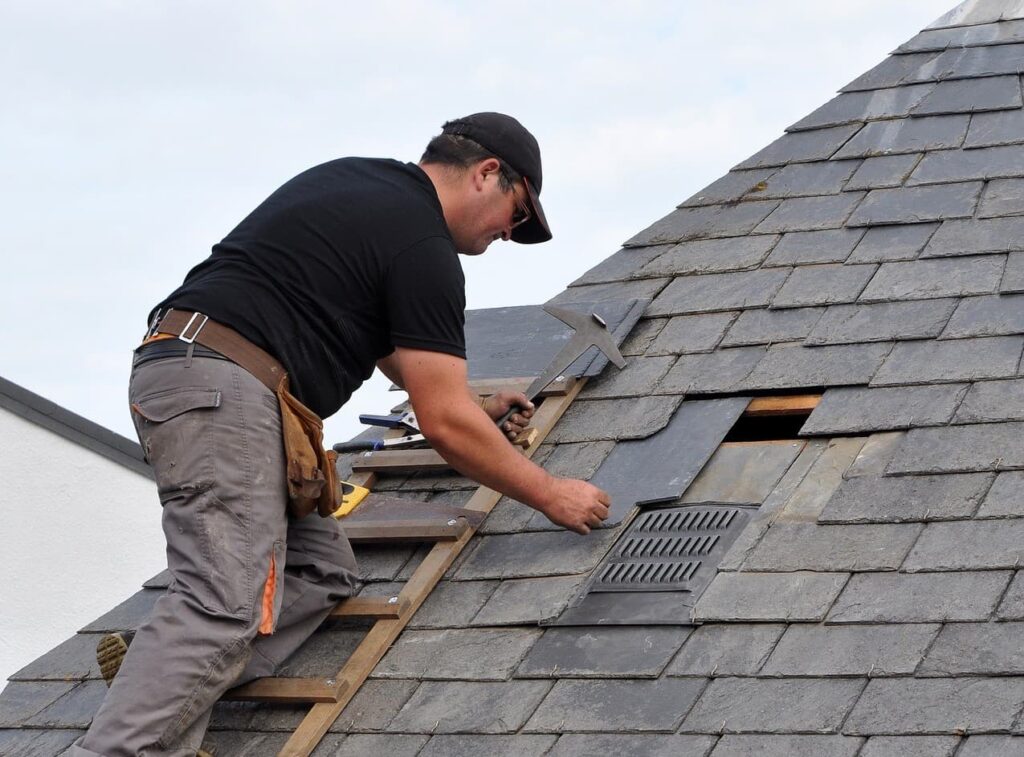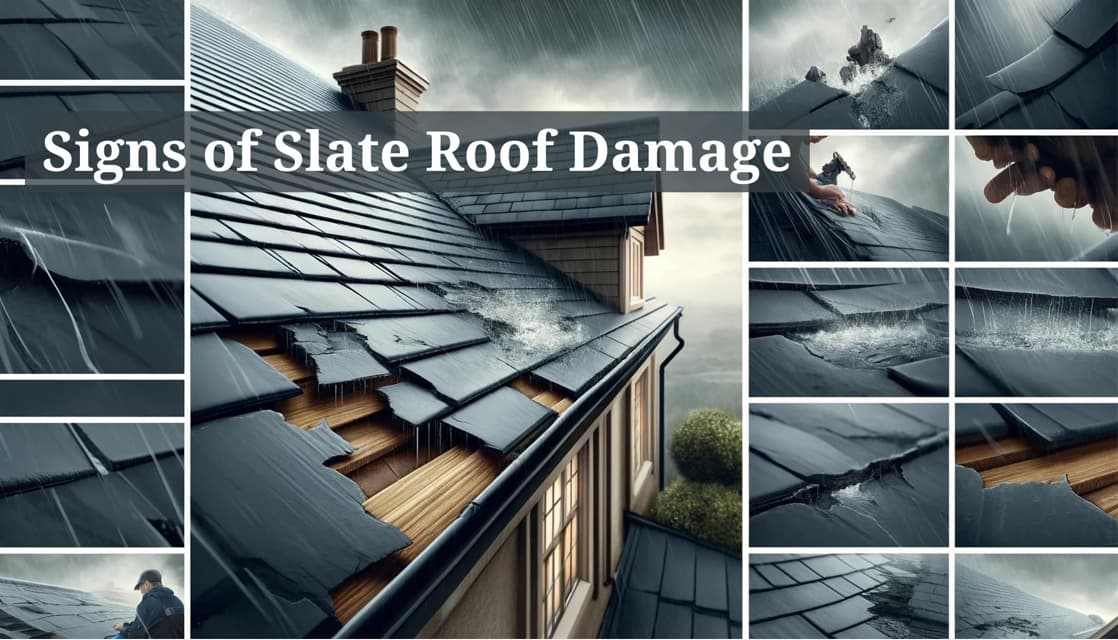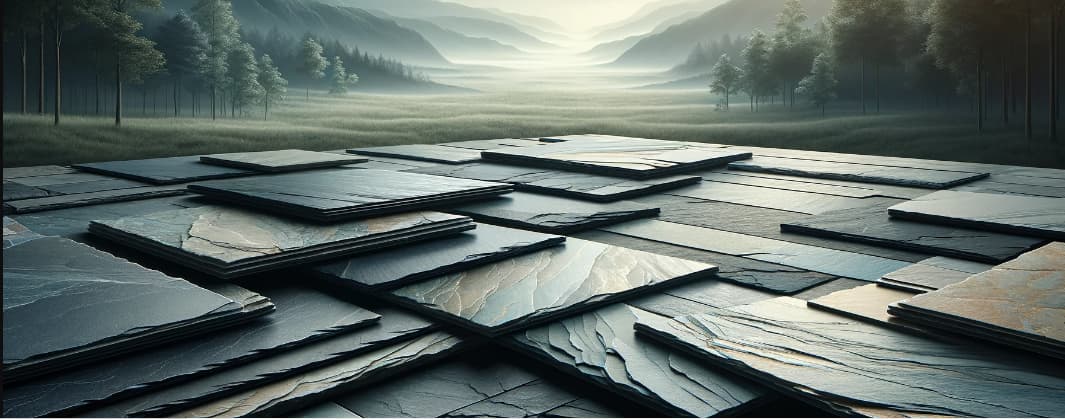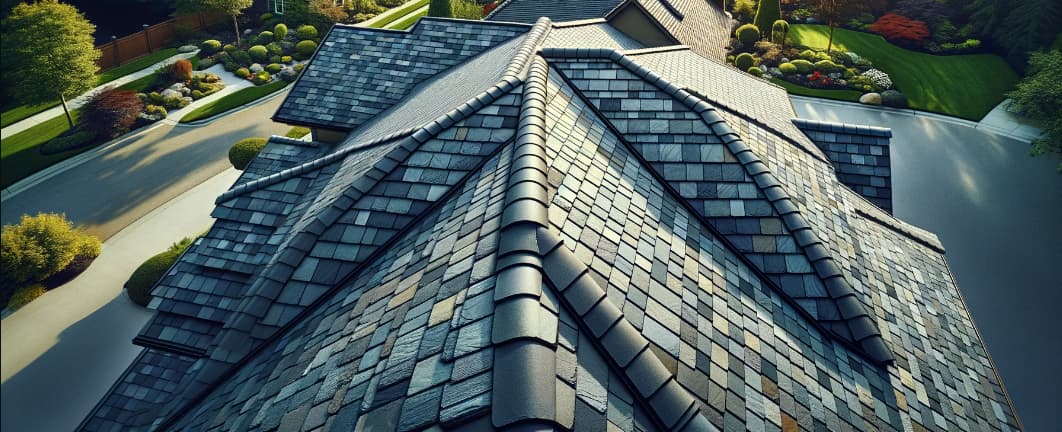Roofing
Slate Roof Repair: Preserve the Elegance and Durability
Slate Roof Repair: Slate roofs, renowned for their timeless elegance and exceptional durability, nevertheless require regular maintenance and repairs to withstand the challenges of time and weather..
This comprehensive guide explores everything you need to know about slate roof repair, from recognizing damage signs and understanding the need for professional intervention to detailing the repair steps and highlighting the long-term benefits of professional roofing expertise.
Learn how to identify the signs of slate roof damage, the benefits of professional repair, and the steps involved in the repair process.
Discover the different types of slate available and the environmental benefits of slate roofs. Avoid common mistakes and learn from real-life examples of successful slate roof repairs.
Protect your investment and preserve the elegance and durability of your slate roof with expert repair services from qualified roofing contractors. Contact us today for a professional inspection and customized repair solutions.
Signs of Slate Roof Damage:
Slate roof damage can manifest in subtle signs or glaring issues.Never ignore signs like hairline cracks, chipped slates, or visible leaks during rainstorms.
Water stains on your ceiling, mold growth in your attic, or a steady drip during a downpour are all red flags indicating potential slate roof problems.
Additionally, if your roof is several decades old, it’s advisable to conduct regular inspections to identify and address issues before they escalate.
DIY vs. Professional Repair:
DIY Slate Roof Repair
Pros:
- Can be less expensive than hiring a professional
- This can be done on your own schedule
- Can give you a sense of accomplishment
Cons:
- Can be dangerous, especially if you are not experienced in working on roofs
- Can be difficult to diagnose and repair problems correctly
- This can lead to costly mistakes if not done properly
- May not be covered by your insurance
Professional Slate Roof Repair
Pros:
- Safe and efficient
- Done by trained and experienced professionals
- Backed by a warranty
- Covered by insurance
Cons:
- More expensive than a DIY repair
- May take longer to schedule
Overall, professional slate roof repair is the best option for most homeowners. It is safe, efficient, and backed by a warranty.
However, if you are experienced working on roofs and are comfortable tackling the job yourself, DIY repair may be a viable option.
Here are some additional things to consider when deciding whether to DIY or hire a professional for slate roof repair:
The extent of the damage:
If the damage is minor, such as a single broken slate, DIY repair may be a good option.
However, if the damage is more extensive, such as a missing slate or a damaged flashing, it is best to hire a professional.
The complexity of the repair:
Some slate roof repairs, such as replacing a broken slate, are relatively straightforward.
However, other repairs, such as repairing flashing or a damaged slate ridge, are more complex and should be done by a professional.
Your safety:
Working on a roof can be dangerous, especially if you are not experienced. If you are not comfortable working on a roof, it is best to hire a professional.
If you are unsure whether to DIY or hire a professional for slate roof repair, it is always best to err on the side of caution and hire a professional.
A professional roofer will be able to assess the damage and recommend the best course of action.
Types of Slate:
Slate, a metamorphic rock, splits into thin, flat sheets and has served as a roofing material for centuries due to its durability, weather resistance, and fire-retardant properties.
The three main types of slate used for roofing include:
Natural slate:
This is the most expensive type of slate, but it is also the most durable and long-lasting. Natural slate is quarried from around the world and comes in a variety of colors and textures.
Synthetic slate:
Synthetic slate is made from recycled materials such as plastic and rubber. It is less expensive than natural slate, but it is not as durable. Synthetic slate is available in a variety of colors and textures that mimic natural slate.
Composite slate:
Composite slate is a combination of natural and synthetic materials. It is less expensive than natural slate and more durable than synthetic slate. Composite slate is available in a variety of colors and textures.
When choosing a type of slate for your roof, it is important to consider your budget, the climate you live in, and the overall aesthetic of your home.
Here is a table that summarizes the key differences between the three types of slate:
| Type of slate | Pros | Cons |
| Natural slate | Most durable and long-lasting | Most expensive |
| Synthetic Slate | Less expensive than natural slate | Not as durable as natural slate |
| Composite slate | Less expensive than natural slate and more durable than synthetic slate | Not as durable as natural slate |
Environmental Benefits:
Slate roofs offer a number of environmental benefits, including:
Sustainability: Slate is a natural material that is quarried from the earth. It is a renewable resource, meaning that it can be replenished over time.
Durability: Slate roofs are extremely durable and can last for centuries. This reduces the need to replace the roof, which saves resources and reduces waste.
Energy efficiency: Slate roofs have a high thermal mass, which means that they absorb and retain heat well.
This helps to regulate the temperature inside a building, reducing the need for heating and cooling systems. This can save energy and reduce greenhouse gas emissions.
Recyclability: Slate is a recyclable material. At the end of its lifespan, a slate roof can be recycled into new products, such as roofing tiles, flooring tiles, and landscaping materials. This reduces the amount of waste that goes to landfills.
In addition to these environmental benefits, slate roofs also provide a number of other advantages, such as:
Fire resistance: Slate is a fire-resistant material. This can help to protect your home from fire damage.
Weather resistance: Slate roofs are resistant to all types of weather, including rain, snow, hail, and wind. This can help to extend the lifespan of your roof and reduce the need for repairs.
Low maintenance: Slate roofs are very low maintenance. They do not need to be painted or stained, and they can be easily cleaned with a hose.
Overall, slate roofs are a sustainable, durable, and energy-efficient roofing option. They offer a number of environmental benefits and can help to reduce your home’s environmental impact.
Here is a specific example of how slate roofs can help to reduce greenhouse gas emissions:
A study by the National Slate Association found that a slate roof can save up to 20 tons of carbon dioxide over its lifespan. This is equivalent to the emissions from driving a car for over 50,000 miles.
If you are looking for a sustainable and environmentally friendly roofing option, a slate roof is a great choice.
Common Mistakes to Avoid:
When attempting DIY slate roof repairs, several mistakes can exacerbate the issue.
Using incorrect-sized or mismatched slates, improper installation techniques, and neglecting underlying problems are common errors.
It’s crucial to avoid these pitfalls to ensure the repair is effective and long-lasting.
Case Studies and Testimonials:
Real-life examples of successful slate roof repairs and customer testimonials can instill confidence in homeowners seeking professional help.
These stories serve as evidence of the expertise and reliability of roofing professionals, reassuring homeowners that their roofs are in capable hands.
Steps for Slate Roof Repair:
Professionals follow a meticulous process for slate roof repair to ensure a seamless and durable solution. Here’s a detailed breakdown:
1. Thorough Inspection: A professional roofer starts with a comprehensive inspection to identify all damaged or deteriorating slates.
2. Slate Replacement: Specialists use specialized tools to carefully remove damaged slates, avoiding harm to adjacent slates.
3. Surface Preparation: The underlying surface is cleaned and prepped for the new slates, providing a solid foundation for the repair.
4. Matching Slate: We meticulously select replacement slates to match the existing slates’ color, thickness, and texture, ensuring a uniform appearance.
5. Installation: Using industry-standard techniques, each slate is securely installed to endure harsh weather conditions.
6. Weatherproofing: We apply proper weatherproofing measures, such as flashing and sealants, to prevent future leaks and water ingress.
Benefits of Professional Repair:
Investing in professional slate roof repair offers a multitude of benefits:
Expertise: Roofing professionals bring years of experience and technical knowledge to the table, ensuring precise diagnosis and effective repairs.
Quality Materials: Reputable roofers have access to high-quality slates and materials, guaranteeing the longevity of the repair.
Time and Cost Efficiency: Professionals efficiently complete repairs, minimizing downtime and reducing the overall cost in the long run.
Warranty and Assurance: Reputable roofing companies provide warranties for their work, offering peace of mind to homeowners regarding the quality of the repair.
Cost of Slate Roof Repair:
The cost of slate roof repair varies based on several factors, including the extent of the damage, the type of slate used, and the complexity of the repair.
While minor repairs might be relatively affordable, extensive damage or intricate architectural designs may require a more significant investment.
However, considering the long-term benefits and enhanced lifespan of your roof, professional repair is a sound financial decision.
Maintenance Tips to Prevent Future Damage:
Beyond repairs, proactive maintenance plays a pivotal role in the longevity of your slate roof:
Regular Inspections: Schedule annual inspections to identify potential issues before they escalate.
Gutter Maintenance: Keep gutters clear of debris to prevent water buildup, which can damage the roof’s edge and structure.
Tree Trimming: Trim overhanging branches to prevent falling debris and scratches, which can damage the slates.
Prompt Repairs: Address minor issues promptly to prevent them from worsening over time and causing more extensive damage.
Future Trends and Innovations:
The slate roofing industry is continually evolving. New materials, innovative coatings, and advanced installation techniques are shaping the future of slate roofs.
Homeowners can stay ahead of the curve by exploring these trends, ensuring their roofs benefit from the latest advancements in technology and durability.
Maintenance Plans:
Discuss the benefits of regular maintenance plans offered by roofing companies.
Explain how these plans can save homeowners money in the long run by identifying and addressing issues before they escalate.
Local Regulations and Permits: Key Points
Understanding and complying with local regulations and permits is essential for a smooth and legally sound slate roof repair project.
Understand Local Codes: Familiarize yourself with building codes, historical district rules, and permit requirements specific to your area.
Professional Guidance: Consult roofing experts who understand local regulations to ensure compliance during repairs.
Benefits: Complying avoids legal issues, enhances property value, and ensures a smooth slate roof repair process.
Conclusion:
Slate roofs are a timeless and elegant roofing option that offers a number of benefits, including durability, weather resistance, fire resistance, and low maintenance.
In addition, slate roofs also offer a number of environmental benefits, such as sustainability, energy efficiency, and recyclability.
If you are looking for a durable, sustainable, and environmentally friendly roofing option, a slate roof is a great choice.
With proper maintenance, a slate roof can last for centuries, protecting your home from the elements and adding value to your property.
Here are some key takeaways from this article:
1. Slate roofs are renowned for their durability and longevity. They can last for centuries with proper maintenance.
2. Slate roofs are resistant to all types of weather, including rain, snow, hail, and wind.
3. Slate roofs are fire resistant, providing an extra layer of protection for your home.
4. Slate roofs are low-maintenance and do not need to be painted or stained.
5. Slate roofs are a sustainable and environmentally friendly roofing option. They are made from a natural material, are recyclable, and have a high thermal mass, which helps to reduce energy consumption.
If you are considering a new roof for your home, I encourage you to learn more about the benefits of slate roofs. Slate roofs are an investment that will pay off for years to come.
Preserve the elegance of your slate roof. Contact us today for a professional inspection and expert repair services tailored to your roofing needs!
Frequently Asked Questions
1. Can slate roofs be patched?
A. Yes, you can patch slate roofs. Minor damages like cracked or chipped slates can often be repaired without replacing the entire roof.
2. Can slate roof tiles be repaired?
A. Absolutely. Professionals can replace or repair individual slate tiles that are damaged, ensuring the roof’s integrity.
3. Should you repair a slate roof?
A. Yes, timely repairs are crucial to maintaining a slate roof’s durability and preventing further damage. Professional assessments can help determine the necessary repairs.
4. What are common slate roof repairs?
A. Common slate roof repairs include replacing cracked or missing slates, fixing leaks, addressing damaged flashing, and repairing underlying structural issues.
5. The slate roof repair cost
A. Repair costs vary based on the extent of damage. Minor repairs can be affordable, while extensive repairs may require a more significant investment. It’s best to obtain quotes from professionals.
6. How to repair a slate roof from the inside
A. We do not recommend repairing a slate roof from the inside, as it fails to address the root cause of the issue. It’s essential to have repairs done from the exterior by professionals.
Slate repair glue
Professionals use specialized slate roof adhesives or sealants to repair minor cracks or secure slates. These adhesives ensure a strong and durable bond.
Slate roof repair clips
Professionals use metal fixtures called slate roof repair clips to secure loose or slipping slates, ensuring they remain in place and maintain the roof’s integrity.
DIY slate roof repair
While you can handle minor DIY repairs like replacing a single slate, you should leave complex repairs to professionals.. DIY attempts on significant issues can lead to further damage.
Slate hooks
Professionals use slate hooks to secure slates in areas prone to slipping. These hooks provide additional support, ensuring slates stay in place during adverse weather conditions.
Hall hook slate repair
Hall hook slate repairs involve using hooks to secure slates on the roof. These hooks insert under slates to prevent them from sliding or falling out of place.
Recent Posts
- Flat Roof – Decoding: Installation, Maintenance, and Materials
- Black Metal Roofing : The Comprehensive Guide
- What Are the Best Roofing Shingles for Your Home?
- Rubber Roof Repair – A Comprehensive Guide





